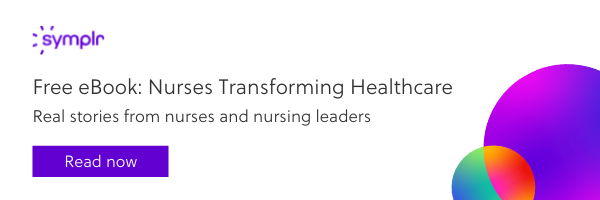Nursing Shortage 101


Nurses are a key part of a healthcare organization’s success and they play a pivotal role in maintaining the quality of care an organization provides to its patients. Unfortunately, we are in the midst of a severe nursing shortage—a crisis that has been exacerbated by COVID-19 and the fallout of effects from the pandemic.
Attracting high-quality nursing talent is a priority for healthcare organizations, but many leaders are finding it more difficult to find, hire, and keep top-tier nursing staff. In this article, we’ll explain what’s behind the nursing shortage, how it’s affecting the healthcare industry, and how healthcare leaders can attract and retain top-quality nursing talent at their organizations.
Why is there a nursing shortage?
With a projected growth rate of 7% from 2019–2029, nursing is one of the fastest-growing occupations in the country. Despite the optimistic growth rate, however, healthcare organizations are struggling to find nursing staff. For healthcare leaders to effectively navigate the nursing shortage, the first step is understanding the root causes.
COVID-19
It's tempting to think of the COVID-19 pandemic as the key driver of the shortage of nurses, but as you’ll see below, that’s not entirely accurate. The impossibly high stress the pandemic has placed on nurses has, of course, only worsened the problem. But nursing shortages were already an area of critical concern well before COVID-19 hit the United States.
Increased demand
Demand for nurses has been on the rise for some time. There are a number of factors driving this increase, but a 2015 report from the Georgetown University Center on Education and the Workforce found that three key contributors were:
- A retirement boom among older nurses, many of whom are part of the Baby Boomer generation
- The passage of the Affordable Care Act, which expanded health insurance coverage and, in turn, spiked the number of patients eligible for and seeking healthcare
- An insufficient number of faculty, facilities, and training sites at nursing schools to properly train all nursing candidates
We are getting older
Another key factor in the increased demand for nurses is an aging population. There are more than 46 million adults aged 65 and older living in the U.S.—a number that is projected to increase by almost 18 million by the end of the decade. Older adults are more likely to suffer from chronic illnesses than younger people, which means they have a much higher probability of hospitalization, have more complex care needs, and are more likely to need ongoing care.
The retirement boom
The retirement boom among older nurses has created a significant "brain drain" and has created thousands of job openings in nursing. The massive increase in job openings has coincided with an increase in the number of patients, but there simply aren’t enough new nurses entering the workforce each year to keep pace with these rising rates.
The Bureau of Labor Statistics expects the registered nurse workforce to grow by an average of 30,000 new nurses per year from 2019–2029—but that’s nowhere near enough to meet the Bureau’s projection of 175,900 openings each year over the same time period. Some studies have projected that 1.2 million more nurses will be needed by 2030 in order to keep pace with this high demand.
Location matters
When it comes to attracting top nursing talent, location plays a major role. The U.S. has a national average of 12.06 nurses per 1,000 members of the population, but 20 states fall below that average, and only five states have more than 16 nurses per 1,000 people. Nurse shortages more acutely affect rural areas, primarily because they are often considered less desirable places to live. However, this can also be a benefit to organizations in these areas, as there is decreased competition for nurses.
Another factor to consider is licensure and scope of practice: Some states give RNs less freedom to operate and require more oversight than others. This can be a deterrent for high-quality or advanced practice registered nurses, especially experienced nurses who are accustomed to practicing to the upper limits of their license in their current location.
Shortage of nursing educators
The nursing shortage is a big enough problem on its own, but there is an underlying factor that has exacerbated the issue: a shortage of educators. Nursing schools across the country are experiencing a faculty shortage, which limits the number of nursing students schools can accept.
A report from the American Association of Colleges of Nursing found that in 2019, U.S. nursing schools turned down 80,407 qualified applicants for graduate and baccalaureate nursing programs. The main reasons were:
- Insufficient numbers of faculty and clinical preceptors
- Not enough clinical sites or classroom space
- Budget constraints
A separate survey found that nursing schools not only needed to create more faculty positions to accommodate demand, but that they were struggling to fill existing faculty vacancies.
Job stress
Nursing is a high-stress profession under the best of circumstances. Nurses not only have to deal with increasing workloads, an overall lack of power and influence, and ambiguity and conflict in their roles, but they have to do it while also dealing with human suffering and loss of life on a regular basis. On top of that, because nurses interact directly with patients more frequently than any other provider, they are at the highest risk of workplace violence of any healthcare professional. Nurses universally agree that theirs is an incredibly rewarding profession, but can be an unforgiving one, as the recent pandemic has shown us.
The impact of the nursing shortage
Patient-centered staffing
The needs for nursing care differ greatly among patients. Determining the numbers of nursing hours of care needed based on the needs of the patients is a crucial determining factor in the quality of care patients receive and of their overall outcomes.
Fluctuations in the severity of a patient's illness, the needs of the family, and a multitude of other factors go into determining the number of hours the patient needs. Matching the patient's needs with the qualifications and skills of the nurse creates the individualized care that other methodologies (e.g., ratios, matrices, etc.) cannot. When the correct matching of the patient's needs with the skills of the nurse cannot happen during severe shortages, nurses become concerned, which leads to burnout and resignations.
Greater risk of burnout
Higher nurse-to-patient ratios are a key contributing factor to nurse burnout—which, as we have discussed before, poses its own risks to patient safety and health outcomes. In any profession, there are only so many tasks an employee can take on before their performance starts to diminish, and nursing is no exception. This is another key contributor to burnout: 72% of CNOs at healthcare organizations acknowledged nursing shortages, and most believe those shortages will only worsen over time. Many nurses are able to effectively manage increased workloads for a set period of time, but when they are expected to handle more patients and work longer hours indefinitely, very few nurses can avoid the inevitable feelings of exhaustion and burnout.
The American Organization for Nursing Leadership recently completed a three-part longitudinal study of nursing leaders that documents their continually worsening job satisfaction, burnout, and intent to leave the profession.
Reduced quality of care
Nurses are directly responsible for maintaining the quality of care a healthcare organization provides. And considering how closely they work with patients, nurses can often be the difference between high-quality and substandard care. However, the nursing shortage means there are fewer nurses caring for more patients—and according to some studies, this could mean an increase of 20% or more in negative patient outcomes. The causes of these outcomes may vary, but they include a higher risk of adverse events, including medication errors and deaths, that are commonly associated with overworked and under-supported nursing staff within a healthcare organization.
Poor patient experiences
Even if the nursing shortage does not lead to negative patient outcomes, the nursing shortage can still have a harmful impact on the overall patient experience. Nurses are the most common patient-facing role found within a healthcare organization, which means that patient satisfaction can often depend solely on the quality of their interactions with the nursing staff.
Poor patient experiences can also affect readmittance rates. Nurses are often responsible for patient education: ensuring the patient understands their health and their care management moving forward. Without this key element of the patient experience, there is the risk that the patient’s condition will deteriorate post-discharge. In many cases, this leads to the patient being readmitted, which, in turn, further increases the patient load for nursing staff. Poor quality is related to lower financial outcomes, which creates more of a problem of having adequate resources to care for patients.
Financial impact
The shortage of new nurses puts nursing staff at an increased risk of burnout. And as we have discussed in previous articles, burnout comes with a financial cost. Each instance of staff RN turnover costs healthcare organizations an average of $40,038—and that’s assuming there is turnover.
In many cases, nurses who are experiencing feelings of burnout don’t quit their jobs; they just try to do the best they can with the resources they have. However, burned-out nurses are more prone to errors, and a recent study found that errors cost healthcare organizations about $20 billion per year overall.
Solutions for the nursing shortage
Having a better understanding of the problem is an important first step toward solving it, but what can actually be done to reduce the nursing shortage in healthcare organizations? Here are a few key solutions that could help bring this problem under control.
Strategic workplace accommodations and flexibility
It’s an inescapable fact that nurses are overworked. A 2016 poll found that four out of five nurses feel they play a larger role in patient care management than they did just two years prior. On top of that, 83% of nurses cited poor work/life balance as the main reason that hospitals and healthcare organizations are losing good nurses. Healthcare organizations and leaders may not be able to do much to reduce nurse workloads, but there are things they can do to help make life a little easier for overworked nurses in the meantime.
Healthcare leaders should consider implementing strategic workplace accommodations to help nurses more effectively manage job stress. These accommodations can vary depending on the specific needs of an organization’s nursing staff, but examples include allowing nurses additional break time during their shifts to de-stress, or holding departmental group sessions to talk about health. Healthcare organizations can also create physical space where nurses can go to take a breather when things get hectic.
Additional flexibility also goes a long way toward restoring work/life balance for an organization’s nursing staff. The easiest way for leaders to provide that flexibility is to listen when nurses voice concerns about high patient loads or feeling overwhelmed and do everything they can to reduce those stressors. Effective staffing, technology, and workforce management can be a great way to build in this flexibility without increasing the workload for other nurses. It is imperative that we make our clinical settings less stressful with better, more useful technology.
Improve the work environment
As with the problem of increased patient loads, there is only so much healthcare leaders can do to improve the work environment. But whatever healthcare leaders can do to make improvements will be greatly appreciated by their organization’s nursing workforce.
We’ve previously discussed why it’s so important to create a culture of safety within a healthcare organization, and it’s worth reiterating here. Not only will focusing on nurse safety benefit each nurse as an individual (as well as their patients), but it can be the foundation for a collaborative environment that many nurses feel is missing from traditional healthcare settings.
These are things that healthcare leaders and organizations can do right now to help mitigate the effects of the nursing shortage, but these are short-term solutions. To ensure that the nursing shortage does not remain a persistent problem in healthcare, there also needs to be an increased focus on long-term solutions, including the following.
Lobbying and advocacy
Many nursing organizations, such as the American Nurses Association, have focused on lobbying and advocacy, and those efforts need to continue in the years to come. There are massive disparities in the quality of healthcare from state to state (and even region to region within a given state).
Increased access to education
Improving access to nursing education is the only way to truly end the nursing shortage. Patient numbers will only continue to rise, and the current rates of nurse burnout and nursing staff turnover make it clear that simply asking nurses to do more with less is unsustainable. We need more new nurses to fill the positions left vacant by the wave of retiring nurses, and to increase the number of nurses, we need to ensure that all qualified candidates can access the education they need to begin a career in nursing.
To reduce the effects of the nursing shortage at their organizations, healthcare leaders will need to support these efforts and ensure that they create the right environment at their organizations to attract and retain top nursing talent.
The team at symplr can help leaders identify ways to create an ideal environment for attracting new nursing talent, as well as offer workforce management solutions to help organizations keep the nurses they already have. To learn more, request an assessment today.
